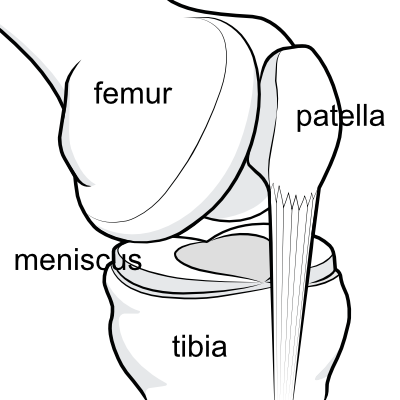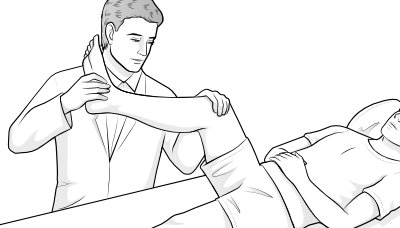The McMurray test assesses the integrity of the menisci, the crescent-shaped pair of shock absorbers in the knee.
 Page updated July 2024 by Dr Sheila Strover (Clinical Editor)
Page updated July 2024 by Dr Sheila Strover (Clinical Editor)

Illustration showing the crescentic meniscus between the tibia and the rounded end of the femur on either side of the joint.

A longitudinal meniscal tear.
How is the McMurray test performed?
-
Quote from peer-reviewed paper:
"....intertester reliability using the McMurray's test is low. This is not surprising given the complicated nature of the technique and the difficulty in controlling the amount and direction of forces across testers...."
Citation: Hing W, White S, Reid D, Marshall R. Validity of the McMurray's Test and Modified Versions of the Test: A Systematic Literature Review. J Man Manip Ther. 2009;17(1):22-35. doi: 10.1179/106698109790818250. PMID: 20046563; PMCID: PMC2704345.
What does a positive McMurray test mean?
A positive test will be recorded in the notes, but it is not highly diagnostic of a tear in the meniscus, and more investigations are likely indicated. Conversely, a negative test means that no click or pain was elicited, but it does not necessarily mean that all is well inside the knee.
The whole story needs to be taken into consideration - history of an injury, what disability was experienced after the injury, history of post-injury swelling, feelings of instability - it will all help towards making an evaluation.
In terms of other office tests, Ege's test has a better reputation for accuracy. MRI scan is considered the diagnostic investigative method of choice for meniscus tears, but it has a high cost and may pick up false positives.
-
Quote from peer-reviewed paper:
"Clinical tests like McMurray and joint line tenderness have low diagnostic value when applied individually.... They may be useful when combined together with the background of clinical history."
Citation: Gupta Y, Mahara D, Lamichhane A. McMurray's Test and Joint Line Tenderness for Medial Meniscus Tear: Are They Accurate? Ethiop J Health Sci. 2016 Nov;26(6):567-572. doi: 10.4314/ejhs.v26i6.10. PMID: 28450773; PMCID: PMC5389077.
What is the best test for a meniscus tear?
Arthroscopy remains the gold standard for definitive diagnosis, but of course it is an invasive procedure.
During an arthroscopy, the surgeon will use a blunt probe to feel each area of the menisci for tears, as well as along the outer edge in case the meniscus has avulsed away from the capsule.
-
Quote from peer-reviewed paper:
"....no clinical assessment or advanced investigations such as MRI diagnose meniscal tears in all patients....The advent of arthroscopy of the knee has revolutionalised the diagnosis and treatment of meniscal tears"
Citation: Mohan BR, Gosal HS. Reliability of clinical diagnosis in meniscal tears. Int Orthop. 2007 Feb;31(1):57-60. doi: 10.1007/s00264-006-0131-x. Epub 2006 Apr 22. PMID: 16633811; PMCID: PMC2267536.
What is the relevance of a meniscus tear?
A torn meniscus may cause knee instability, leading to falls and possible extension of the tear, and even stressing the cruciate ligaments so they become damaged also.
Most knee surgeons would feel it important to try to stabilise the knee by repairing the meniscus where possible, but there are controversies about patient selection.
-
Quote from peer-reviewed paper:
"Selecting the correct treatment can be challenging and involves multiple factors."
Citation: Mordecai SC, Al-Hadithy N, Ware HE, Gupte CM. Treatment of meniscal tears: An evidence based approach. World J Orthop. 2014 Jul 18;5(3):233-41. doi: 10.5312/wjo.v5.i3.233. PMID: 25035825; PMCID: PMC4095015.
Forum discussions
- medial meniscus tear / posterior horn
Patients discussing test results with meniscus tears.
- New to this - will I need surgery? Please help!
A patient trying to understand the tests.
Navigation -
Video - a typical story -
 2012 - Medial meniscus tear - a typical story - by Professor Adrian Wilson (Knee Surgeon) (Knee Surgeon)
2012 - Medial meniscus tear - a typical story - by Professor Adrian Wilson (Knee Surgeon) (Knee Surgeon)
Important expert consensus -
- 2020 - Management of traumatic meniscus tears: the 2019 ESSKA meniscus consensus - Consensus paper published by the European Society for Sports Traumatology, Knee Surgery and Arthroscopy and summarised for you by Dr Sheila Strover (Clinical Editor)
